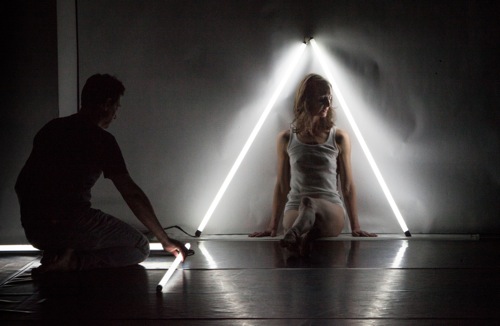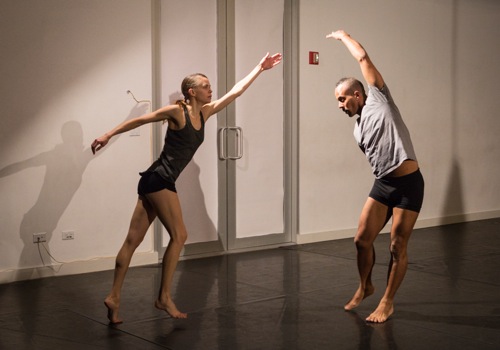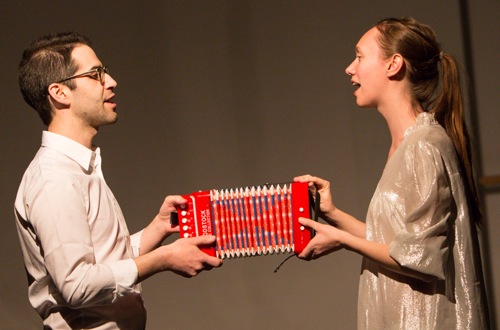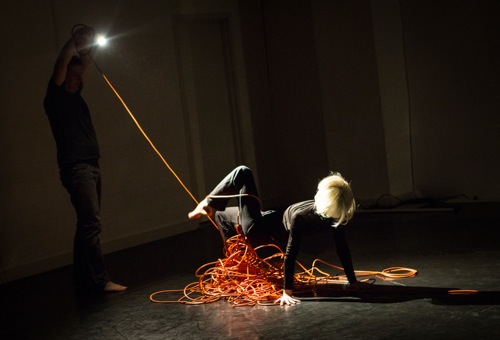Kimberly Bartosik/Daela premieres a work at New York Live Arts
A lighting designer and a choreographer walk into a bar and. . . . No this is not a way to begin, especially if a joke doesn’t ensue; instead, the sentence announces a life-and-art collaboration that more likely began backstage.
Kimberly Bartosik, the choreographer, and Roderick Murray, the lighting designer, have collaborated on a number of works, but in none of them has their partnership been so intimately portrayed as in the first section of Bartosik’s You are my heat and glare. The title comes from poet Anne Carson’s long poem “The Anthropology of Water,” and the piece’s three duets explore the forces of desire and frustration that lick at the edges of a relationship until they burn into it, as well as the sweet harmony existing between lovers who are perfectly attuned.
Composer-singer Gelsey Bell and singer Dave Ruder (also credited as an arranger) begin and end You are my heat and glare and also divide its two darker episodes. Already singing, the pair lead some of us up the stairs at New York Live Arts, where, along with those audience members who have arrived by elevator, we file into chairs and onto cushions in the large third-floor studio. “Love is a mystery inside this walking” is the opening, oft-repeated sentence that Bell and Rudner sing in beguiling harmony as they pace around the perimeter of the space. They also conclude the evening by coming from behind the audience, singing again. This time, I catch other words. “What can I withstand?” rhymes with “water in my hand.” In the peaceful middle of the work, they stand face-to-face, holding a small, bright-colored concertina between them. They chant a conversation about a journey, a road, retracing their steps; he pulls and pushes evenly; she presses buttons, and the instruments breathes two soft tones.
The positioning of Bell and Ruder’s duets suggests that the good days predominate in You Are My Heat and Glare, or, at any rate, triumph over struggle. And such struggle. The initial singing ends with a flash of light, a blackout, and the reappearance of the single beam. It’s the size of a large flashlight, and it’s being wielded by Murray (although it’s too dark to see him clearly). With it he searches, explores, caresses, intimidates, and challenges Bartosik, who, in her black clothes, is visible mostly as a pale face and a white wig. At first, she’s marooned on Murray’s power source—a tangled nest of orange electrical wires. The contrast between the surrounding darkness and the insidious ray that Murray runs along Bartosik’s leg is extreme, alarming. She is negotiating however—clamping a foot down on the length of cord that her partner stretches up on a diagonal, and gathering the mess of wire around her like a tutu as she stares up into the light he holds just above her head.
The duet takes shape as a compendium of moments in a relationship—each defined by light. Murray enshrines the seated Bartosik (her wig now off) beneath a small tepee made of fluorescent tubes and lays two more to fence him away from her. She stands in the center of the room and watches as he circles her slowly, making her shadow on the side and back walls grow and shrink. Is he stalking her or helping us to see her in all her aspects? He backlights her as she advances toward us, making big, slow dance movements. There’s a startling moment when he’s crouching on the floor, and she falls backward across his lap. And in an oddly jarring sequence, he—maneuvering around her on the floor—puts objects into her hand; they turn out to be barrettes for her to pin her hair back with before she moves among five little lamps that he has laid out on the floor like a garden. Once, when she briefly has control of a light, she points it at him like a gun.

Confined and enshrined: Kimberly Bartosik and Roderick Murray in You are my heat and glare. Photo: Yi-Chun Wu
The first section of a two-part duet for Joanna Kotze and Marc Mann is hard to watch. Your innards knots up in sympathy with theirs. The light is bright, but not their mood. Strong, deep, melodic music with a rock beat (selections by the band Explosions in the Sky) emphasizes how fiercely controlled these two are. They begin facing each other, just as Bell and Ruder did with the accordion, although there’s no harmony between these two. Frowns and grimaces slide onto Kotze’s face and transform into other expressions even more tortured. The prospect of murder crosses their minds, but the rule is clear: they must not touch. They aim body blows and muscular pressure designed to bend each other backward or force a cave-in, but keep air space between them as they twist and swivel. One of them may loom over the other, who crouches low in response.

Joanna Kotze and Marc Mann battle across distances in Kimberly Bartosik’s You are my heat and glare. Photo: Yi-Chun Wu
In this terrible dance, their legs, arms, and bodies never stop shaking with tension—the actions small, tight, and rapid enough to make you think of an old movie flickering. Even when Mann calms down and straightens up, Kotze grasps her own throat as if in a belated response, and when he leaves off the traveling they’re doing in a circle—stepping onto tiptoe, the other leg lifted slightly behind—and exits, she keeps going for a few seconds, staring at the place he just occupied.
The sound becomes louder and snarlier in the blackout that leads into the next section. Now their faces are hidden by their mauve hoodies, their hands covered, their bodies lumpy under matching sweat pants. A row of lights high at the back wall shines down and forward as they stagger and shamble about, wrench themselves into falls, spin dizzily, and bolt into big messy skips. Then they’re in a red down-spot, their legs bare, touching each other in uncertain ways (his hand poking into her hood, her hand grazing his crotch). In different dim light, he arches backward as she unzips his jacket and removes it; he looks like St. Sebastian expecting the arrows. He frees her from her jacket as she bends awkwardly above him. Then they return to their sour revels.
The singing that starts up behind us reminds them and us that tomorrow is another day, and that letting the sun set on your anger is a very bad idea. For the 70 minutes that You are my heat and glare lasts, the spectators, pressed together in a seemingly airless space, are close enough to the performers to feel seared by their intensity and bathed in the blaze and the dimness and the reasonable warmth of their domain. It’s a powerful piece that the six of them have created—ragged in places, fire-molded in others.


